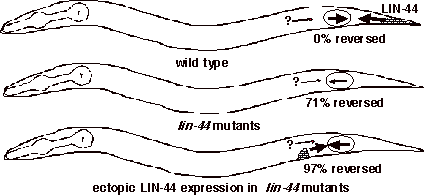
Worm Breeder's Gazette 17(2): 44 (April 1, 2002)
These abstracts should not be cited in bibliographies. Material contained herein should be treated as personal communication and should be cited as such only with the consent of the author.
Laboratory for Cell Fate Decision, CDB, Riken, Kobe 650-0047, Japan
Asymmetric cell division is a fundamental mechanism to produce cellular diversity during development. To divide asymmetrically, mother cells must have polarities. In C. elegans, polarities of mother cells are often regulated by wnt genes. In early development, a polarity of the EMS blastmere is regulated by mom-2/wnt (1, 2). During postembryonic development, polarities of V5 and T cells are regulated by egl-20/wnt and lin-44/wnt, respectively (3, 4). In egl-20 and lin-44 mutants, polarities of the V5 and T cell divisions, respectively, are often reversed. egl-20 and lin-44 are expressed posteriorly to their target cells (4, 5). We have previously proposed that LIN-44 activates LIN-17/Frizzled receptor at the posterior but not anterior side of the T cell to give them a posterior directed polarity (6). The polarity reversal phenotype in lin-44 mutants could be caused by an unidentified signal (wnt?) expressed anteriorly to the T cell. If the hypothesis is correct, posterior expression of wnt must be important. However, Whangbo et al. showed that ectopic expression of egl-20 in pharynx can rescue the polarity reversal of V5 in egl-20 mutants, suggesting that egl-20 has only permissive roles in the regulation of the V5 cell polarity (3). To examine this is also the case for lin-44, we expressed lin-44 similarly in pharynx using the myo-2 promoter to find that it did not affect the T cell phenotype in lin-44 mutants. Because pharynx may be too far from the T cell, we next expressed lin-44 just anterior to the T cell using the egl-5 promoter (expressed in cells around the rectum). Surprisingly, the polarity reversal phenotype in lin-44 mutants was enhanced from 71% to 97 % by the egl-5::lin-44 transgene. The results show that the T cell can recognize direction of the LIN-44 signal, and strongly suggest that LIN-44 instructs direction of cell polarity.

(1) Thorpe et al. Cell 90, 695-705 (1997).
(2) Rocheleau et al. Cell 90, 707-16 (1997).
(3) Whangbo et al. Development 127, 4587-98 (2000)
(4) Herman et al. Cell 83, 101-110 (1995).
(5) Whangbo & Kenyon , Mol Cell 4, 851-855 (1999).
(6) Sawa et al. Genes Dev 10, 2189-2197 (1996).